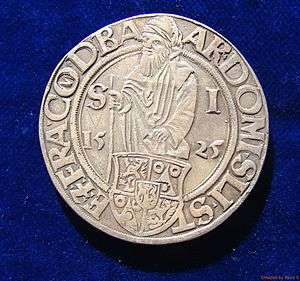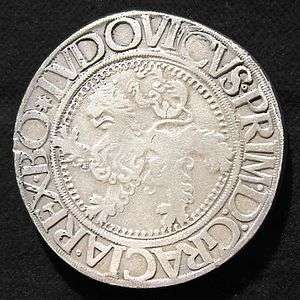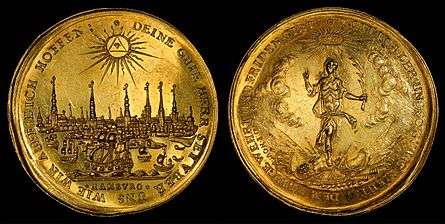Thaler


The thaler was a silver coin used throughout Europe for almost four hundred years. Its name lives on in the many currencies called dollar and, until recently, also in the Slovenian tolar.
To begin with, the name "thaler" was used as an abbreviation of "Joachimsthaler", a coin type from the town of Joachimsthal in the Kingdom of Bohemia and the Holy Roman Empire, where there were silver mines and the first such coins were minted in 1518. The original thaler carried a lion, from the coat of arms of the Kingdom of Bohemia, on its reverse side as well as the Dutch daalders, the leeuwendaalder ("lion thaler"). From an abbreviation of that name come those of three present-day Balkan currencies, the Romanian and Moldovan Leu and the Bulgarian Lev.
Etymologically, Thal is German for "valley" - a "thaler" is a person or a thing "from the valley". The Czech spelling was tolar; many varieties of the term are used in different languages. In the 1902 spelling reform, the German spelling was changed from Thal and Thaler to Tal and Taler, which however did not affect the spelling of "thaler" in English.
Predecessors of Thaler
The roots and development of the thaler-sized silver coin date back to the mid-15th century. As the 15th century drew to a close the state of much of Europe's coinage was quite poor because of repeated debasement induced by the costs of continual warfare, and by the incessant centuries-long loss of silver and gold in indirect one-sided trades importing spices, porcelain, silk and other fine cloths and exotic goods from India, Indonesia and the Far East. This continual debasement had reached a point that silver content in Groschen-type coins had dropped, in some cases, to less than five percent, making the coins of much less individual value than they had in the beginning.
Countering this trend, with the discovery and mining of silver deposits in Europe, Italy began the first tentative steps toward a large silver coinage with the introduction in 1472 of the lira tron in excess of 6 grams (3 7⁄8 dwt), a substantial increase over the roughly 4-gram (2 5⁄8 dwt) gros tournois of France.
In 1474 a 9-gram (5 3⁄4 dwt) lira was issued but it was in 1484 that Archduke Sigismund of Tirol issued the first truly revolutionary silver coin, the half Guldengroschen of roughly 15.5 grams (10 dwt). This was a very rare coin, almost a trial piece, but it did circulate so successfully that demand could not be met.
Finally, with the silver deposits—being mined at Schwaz—to work with and his mint at Hall, Sigismund issued, in 1486, large numbers of the first true thaler-sized coin, the Guldengroschen (golden groat, being of silver but equal in value to a Goldgulden).
The Guldengroschen, nicknamed the guldiner, was an instant and unqualified success. Soon it was being copied widely by many states who had the necessary silver. The engravers, no less affected by the Renaissance than were other artists, began creating intricate and elaborate designs featuring the heraldic arms and standards of the minting state as well as brutally realistic, sometimes unflattering, depictions of the ruler (monarch).
First Bohemian Thaler from Joachimsthal
By 1518, guldiners were popping up everywhere in central Europe. In the Kingdom of Bohemia, then ruled together with Hungary by Louis II of the Jagiellonian dynasty, a guldiner was minted— of similar physical size but slightly less fineness—that was named in German the Joachimsthaler, from the silver mined by the Counts of Schlick at a rich source near Joachimsthal (St. Joachim's Valley, Jáchymov – now in the Czech Republic) where Thal (Tal) means "valley" in German. Joachim, the father of the Virgin Mary, was portrayed on the coin along with the Bohemian lion. Similar coins began to be minted in neighbouring valleys rich in silver deposits, each named after the particular 'thal' or valley from which the silver was extracted. There were soon so many of them that these silver coins began to be known more widely as 'thaler' in German and 'tolar' in the Czech language.
From these earliest 'thaler' developed the new thaler – the coin that the Holy Roman Empire had been looking to create as a standard for trade between the regions of Europe. The original Joachimsthaler Guldengroschen was one ounce in weight (27.2 g). The Empire's Reichstaler (1566 to 1750) was defined as containing 400.99 grains of silver (equal to 25.984 g) and became the coin of account of the whole Empire.
In the 17th century, some Joachimsthalers were in circulation in the Tsardom of Russia, where they were called yefimok (ефимок) - a distortion of the first half of the name.
Later German thalers

The zenith of thaler minting occurred in the late 16th and 17th centuries with the so-called "multiple thalers", often called Lösers in Germany. The first were minted in Brunswick, and indeed the majority were struck there. Some of these coins reached colossal size, as much as sixteen normal thalers. The original reason for minting these colossal coins, some of which exceeded a full pound (over 450 g) of silver and being over 12 cm (5 in) in diameter, is uncertain. The name "löser" most likely was derived from a large gold coin minted in Hamburg called the Portugalöser, worth 10 ducats. Some of the silver löser reached this value, but not all. Eventually the term was applied to numerous similar coins worth more than a single thaler. These coins are very rare, the larger ones often costing tens of thousands of dollars, and are highly sought after by serious collectors of thalers. Few circulated in any real sense so they often remain in well-preserved condition.
In the Holy Roman Empire, the thaler was used as the standard against which the various states' currencies could be valued. One standard also adopted by Prussia was the Reichsthaler, which contained 1⁄14 of a Cologne mark of silver. In 1754, the Conventionsthaler was introduced, containing 1⁄10 of a Cologne mark of silver.
In 1837, the Prussian thaler became part of a currency union which set the value of the southern German gulden at 1 3⁄4 per thaler. By 1850, nearly all German states used this standard of Thaler, though with differing subdivisions.

In 1857, the Vereinsthaler was adopted by most German states as well as in the Habsburg Empire. Vereinsthalers were issued until 1871 in Germany and 1867 in Austria. Within the new German Empire, vereinsthaler coins circulated as 3-mark pieces until 1908 when they were withdrawn and demonetized. Some old countermarked thalers circulated as emergency coinage in Germany during the inflationary period following its defeat in the First World War.
The Maria Theresa thaler was still used during the 20th century in Ethiopia and throughout much of the Arab Peninsula.
Dutch daalder
In the Netherlands, the daalder and rijksdaalder circulated alongside the gulden at values of 1 1⁄2 and 2 1⁄2 gulden.
The kruisdaalder (cross daalder), depicting the Cross of Burgundy, was prevalent in all Dutch provinces, but the currency was replaced by a new daalder after the abjuration of the Spanish king and Duke of Burgundy Philip II in the rebellious provinces. This new coin was no longer depicting the Cross of Burgundy, but a lion, hence its Dutch name leeuwendaalder (lion daalder). This coin was produced from 1575 in six of the seven revolting Dutch provinces and in several Dutch cities.
The leeuwendaalder was authorized to contain 427.16 grains of .750 fine silver and passed locally for between 32 (at introduction in 1576) to 42 stuivers (the stuiver containing less silver over time). It was lighter than the large denomination coins then in circulation, namely the ducatoon (491 grains of .920 fine silver and passing at 3 guilders or 60 stuivers) and the rijksdaalder (448 grains of .885 fine silver passing at 2½ guilders or 50 stuivers). Clearly it was more advantageous for a Dutch merchant to pay a foreign debt in leeuwendaalders rather than in more costly rijksdaalders. Thus, the leeuwendaalder became the coin of choice for foreign trade. The coin was popular in the Middle East, the colonies in the east and in the west. It even was the origin for the names of the Romanian Leu.
Production stopped after the introduction of the new silver coinage based on the gulden by Holland in 1680. This also contained a half 3 gulden of 30 stuiver, which remained to be called Daalder in common speech. Even 200 years after the coin disappeared from circulation, daalder was used as term for an amount of 1 1⁄2 gulden (for instance in the popular commercial jingle "at the market your gulden is worth a daalder").
From New Netherland (New York) the leeuwendaalder or lion dollar spread to all Thirteen Colonies. The term was later applied to a coin used in the Spanish American colonies, which was also widely used in the British North American colonies at the time of the American Revolution, and adopted as the name of the US monetary unit in the late 18th century. Hence the leeuwendaalder became the namesake of the American dollar.[1][2]
The Dutch leeuwendaalder (German löwenthaler) was imitated in several German and Italian cities. These coins circulated in Romania and gave their name to the currencies of Romania and Moldova, the leu, which literally translates to "lion".[3]
In the Netherlands, the name rijksdaalder lived on until the gulden was replaced by the euro in 2002. But in the Caribbean the coin still exists as of today. On Curaçao and Sint Maarten, the Netherlands Antillean guilder will be replaced by the newly created[4] Caribbean guilder no earlier than 2013. The new currency will not keep the rijksdaalder.[5]
Scandinavian daler
The thaler was introduced and became the most widespread currency in Scandinavia under the name daler during the early 17th century. Various daler circulated, including the Danish rigsdaler, the Swedish riksdaler and the Norwegian speciedaler. These daler circulated in Denmark and Sweden until 1873 when they were replaced by the Danish krone and Swedish krona, the new currencies introduced by the Scandinavian Monetary Union. Norway joined the Monetary Union and introduced the Norwegian krone in 1876.
Other "thaler"
As silver flooded into the European economy from domestic and overseas sources, thalers and thaler-sized coins were minted all over with equivalent coins such as the crown, daalder from which the English word "dollar" is derived, krona, and from 1598, the Spanish eight real coin was minted (known as the pirate’s “piece of eight”) — a coin which would later become known in some parts of the world as the peso. Indeed, in England the word "dollar" was in use for the thaler for 200 years before the issue of the United States dollar, and until the half crown ceased to be used following decimalisation in 1971, the term "half a dollar" could be heard for "half a crown". In Switzerland and Germany, coins were minted to commemorate the Schützenfest {Shooting Festival}. These are commonly known as "Shooting thalers".
Legacy

No currency currently in circulation is named thaler. Several, however, acknowledge its legacy with their names: twenty-three currencies named "dollar", used in countries including Australia, Canada, Hong Kong, New Zealand and the United States of America, as well as tolar (Slovene for thaler), used in Slovenia until the end of 2006. Between 1992 and 1995, Belarus planned to introduce Belarusian taler as a national currency.
The birr, the official currency of Ethiopia and Eritrea, takes its name from the local name for thaler, as well as the riyal of many Arabian countries.
In colloquial German, Thaler persisted with the meaning of "three marks" until the 1930s, as when the mark system was introduced in 1871, one Vereinsthaler was revalued at 3 marks.
In Greece, the term taliro (τάληρο) is commonly used for the denomination of five of the local currency (5 drachmae or 5 euros). This reflects the fact that, when introduced in 1833, the new Greek currency, the drachma, corresponded to 1⁄5 of the value of one thaler, the latter coin thus being equivalent to the 5-drachma coin. The term is still used for the 5-euro banknote.
Chronology of Thaler development
- 1486: Sigismund of Tirol issues his 31.93 g Guldengroschen of 60 Kreuzers and .9375 fineness.
- 1493: Switzerland issues its first Guldengroschen at Bern
- 1499: Hungary issues the first Guldiner/Guldengroschen. It is the earliest year of issue with Arabic numerals on the coins in Hungary.
- 1500: The first German Guldengroschen is issued from Saxony, with a value of 24 Groschen. In Bremen it circulates equivalent to 36 Groten. These Guldengroschen are reduced in weight to 29.2 g so as to be minted at eight coins to the Cologne mark.
- 1518: The first coin actually called a "Thaler" is minted in Joachimsthal, Bohemia, Holy Roman Empire. Its weight is as the standard of 1500.
- 1524: In an attempt to standardise the guldiner, a money ordinance (Reichsmünzordnung) is issued at Esslingen, Germany reaffirming the fineness of the coin at 937.5, and its weight to 29.2 g.
- 1534: Saxony and Bohemia alter the fineness of their guldiners down from .9375 purity to .903 while maintaining the same coin weight, thus lowering the actual amount of pure silver in the coin. This begins a separation of the Thaler from its guldiner ancestry.
- 1551: A new money ordinance is decreed in Augsburg that lowers the guldiner's purity to .882, but raises the weight of the coin to 31.18 g. This returns the coin to being the equal value of a Goldgulden. The Thaler is now equivalent to 72 Kreuzer.
- 1559: After the death of the Holy Roman Emperor Charles V, yet another money ordinance is decreed at Augsburg, this time radically altering the coin (now to be called a Reichsguldiner) down to a mass of just 24.62 g, but returning the coin to 931.0 fineness. This sets the Guldiner to be equivalent to 60 Kreuzer once again.
- 1566: The guldiner as a denomination is more or less eliminated by a Saxon money edict that establishes the Reichsthaler (known later as the Speciesthaler) with a fineness of 889.0 and a weight of 29.2 g.
- 1667: An agreement made at the Abbey of Zinna between Saxony, Brandenburg, and Brunswick-Lüneburg to help make the minting of small coins more economical than could be done under the old Augsburg ordinances led to the Thaler being reduced in weight to 28.1 g but retaining the same .889 fineness.
- 1690: The Leipzig Money Convention met to deal with the poor quality of coinage in Saxony, Brandenburg, and Brunswick. The agreement of 1667 had not solved the problem so the thaler was again reduced in weight down to 25.9 g. At this point 12 Thaler are being minted to provide one Cologne mark of silver, up from nine in 1500.
- 1750: This year saw yet another reduction in weight in the areas controlled by Prussia, Hesse, and Brunswick-Wolfenbüttel down to just 22.2 g and a .750 fineness. 14 thalers are minted to contain one Cologne mark of silver.
- 1754: The monetary agreement between Austria and Bavaria in 1753 began the period of the Conventionsthaler, a thaler set at 10 to equal one Cologne Mark of silver. Its weight was 28.0 g with a fineness of .833. Over time this coin spread into a large portion of central and southern Germany.
- 1755: The Kronenthaler (a thaler with 3 or 4 crowns between the Burgundy cross) is first issued in areas controlled by the Habsburgs, especially in the Austrian Netherlands (present-day Belgium) and southern Germany. It had a weight of 29.44 g and a fineness of .873.


- 1857: The Vienna monetary contract finally eliminates the Cologne Mark as a standard against which the silver coinage of Austria and Germany are reckoned, replacing it with a simple tariff of 500 g. Thirty Vereinsthalers are set to be minted from this 500 g standard. The coins weighed 18.5 g and had a .900 fineness. They are set to equal 90 Austrian Kreuzer, 105 Bavarian Kreuzer, 30 Groschen, or 48 Schilling depending on the minting region.
- 1872: The last thalers are minted in a few states, notably Saxony.
- 1908: The last circulating thalers were withdrawn and demonetised in Germany.
- Early years of 20th century: unsuccessful attempt to mint Maria Theresa thaler in Abyssinia. Starting in 1935 Italians mint the coin still popular in the area.[6]
See also
| Wikimedia Commons has media related to Thaler. |
References
- ↑ http://www.coins.nd.edu/ColCoin/ColCoinIntros/DutchCoins.html
- ↑ http://www.coins.nd.edu/ColCoin/ColCoinIntros/Lion-Dollar.intro.html
- ↑ http://www.etymonline.com/index.php?term=leu&allowed_in_frame=0
- ↑ (Dutch) Rijksoverheid.nl - Wat is er veranderd sinds de staatkundige herindeling van het Koninkrijk der Nederlanden?
- ↑ "Antilliaanse gulden wordt aangehouden in 2012". dushi-curacao.info (in Dutch). 14 September 2011. Retrieved 28 September 2011.
- ↑ Kalmer, Joseph; Hyun L. (1935). Abessinien (in German).
